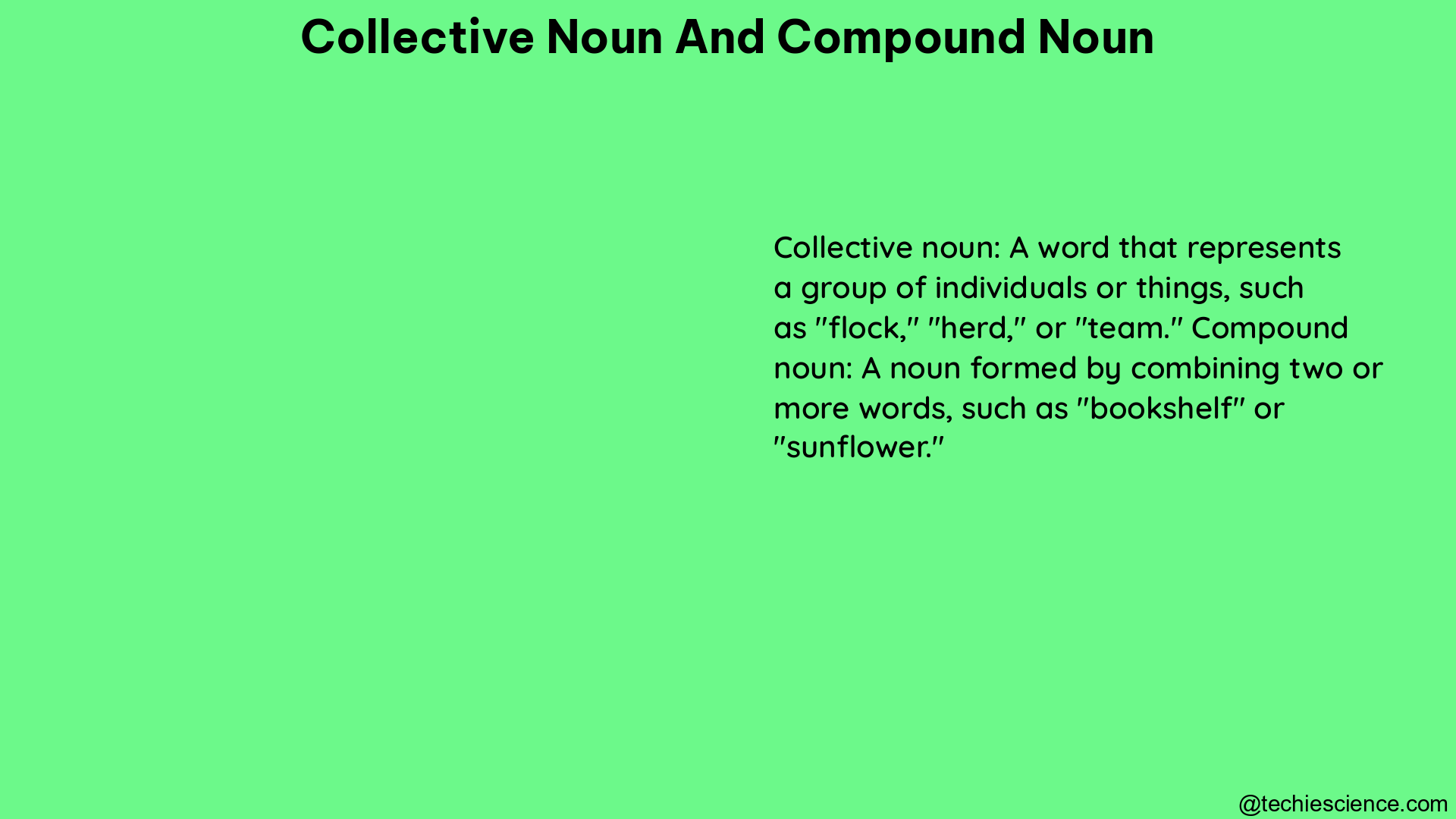Collective nouns and compound nouns are two distinct types of nouns in the English language, each with its own unique characteristics and grammatical specifications. This comprehensive guide will delve into the intricacies of these noun categories, providing a detailed exploration of their formation, usage, and key differences.
Collective Nouns
A collective noun is a single word that represents a group of people, animals, objects, or concepts. These nouns can function as both singular and plural, depending on the context in which they are used.
Examples of Collective Nouns
- Group (of people)
- Class (of students)
- Flock (of birds)
- Army (of soldiers)
- Jury (of jurors)
- Family (of relatives)
- Herd (of cattle)
- Swarm (of bees)
- Bouquet (of flowers)
- Fleet (of ships)
Grammatical Specifications of Collective Nouns
- Singular Usage: Collective nouns can be used as singular nouns, taking a singular verb when referring to the group as a single entity.
-
Example: “The audience was enthusiastic.”
-
Plural Usage: Collective nouns can also be used as plural nouns, taking a plural verb when referring to the individual members of the group.
-
Example: “The crew are all wearing their new uniforms.”
-
Pronoun Agreement: When using a collective noun, the pronoun used to refer to the group can be either singular or plural, depending on the intended meaning.
- Singular pronoun: “The team has finished its work.”
-
Plural pronoun: “The team have finished their work.”
-
Collective Noun Modifiers: Collective nouns can be modified by adjectives or other determiners to provide more specific information about the group.
-
Example: “A large flock of birds” or “The entire jury was present.”
-
Collective Noun Variations: Some collective nouns have specific variations based on the type of group they represent.
- Example: “a herd of cattle” vs. “a flock of sheep”
Collective Noun Usage Considerations
- When referring to the group as a whole, use a singular verb.
- When referring to the individual members of the group, use a plural verb.
- Consider the context and intended meaning when choosing the appropriate pronoun to use with a collective noun.
- Be aware of any specialized collective noun variations that may apply to the specific group being referenced.
Compound Nouns

A compound noun is a noun formed by combining two or more words to create a new word. These compound words can be written as a single word, separate words, or hyphenated words.
Examples of Compound Nouns
- Rainbow (rain + bow)
- Ice cream (ice + cream)
- Bluebird (blue + bird)
- Baseball (base + ball)
- Self-confidence (self + confidence)
- Toothbrush (tooth + brush)
- Greenhouse (green + house)
- Drawback (draw + back)
- Washing machine (washing + machine)
- Firefighter (fire + fighter)
Grammatical Specifications of Compound Nouns
- Compound Noun Forms:
- Single Word: baseball, caregiver, willpower
- Separate Words: guest of honor, school bus, North Forest High School
-
Hyphenated Words: self-confidence, president-elect, Stratford-On-Avon
-
Singular and Plural Usage: Compound nouns follow the same grammatical rules as other nouns, functioning as both singular and plural nouns.
- Singular: “The baseball game was exciting.”
-
Plural: “The baseballs were scattered across the field.”
-
Compound Noun Modifiers: Compound nouns can be modified by adjectives, determiners, or other modifiers, just like other nouns.
-
Example: “The old baseball bat” or “Those ice cream cones are delicious.”
-
Compound Noun Formation Patterns:
- Two Nouns: chopstick, notebook, toothbrush
- Adjective and Noun: greenhouse, blackboard, software
- Adjective and Verb: dry-cleaning, public speaking
- Noun and Verb: rainfall, sunshine, haircut
- Verb and Adverb: drawback, takeover, countdown
- Gerund and Noun: washing machine, swimming pool
Key Differences between Collective Nouns and Compound Nouns
- Formation:
- Collective nouns are single words that refer to a group.
-
Compound nouns are formed by combining two or more words to create a new word.
-
Function:
- Collective nouns can be used as both singular and plural nouns, depending on the context.
-
Compound nouns follow the standard noun grammar rules, functioning as both singular and plural nouns.
-
Grammatical Considerations:
- Collective nouns can take either singular or plural verbs and pronouns, based on the intended meaning.
- Compound nouns follow the same grammatical rules as other nouns, without the singular/plural flexibility of collective nouns.
Advanced Considerations
- Nouns with Both Collective and Compound Characteristics:
-
Some nouns can be both compound and collective, such as “homeroom,” which is a compound noun (home + room) and can also refer to a group of students.
-
Compound Noun Variations:
-
Compound nouns can have different forms, such as “ice cream” (separate words), “baseball” (single word), and “self-confidence” (hyphenated).
-
Compound Noun Ambiguity:
- Some compound nouns can have multiple interpretations, depending on the context and the relationship between the individual words.
- Example: “Blackbird” can refer to a bird that is black or a type of bird called a blackbird.
Exercises and Resources
For comprehensive exercises and answer keys related to collective and compound nouns, refer to the following resources:
- Tutorified Compound and Collective Nouns PDF: https://tutorified-wp-bucket.s3-accelerate.amazonaws.com/2021/08/Compound-and-Collective-Nouns.pdf
- Socratic article on the difference between collective and compound nouns: https://socratic.org/questions/what-is-the-difference-between-a-collective-noun-and-a-compound-noun
- Thesaurus.com article on compound nouns: https://www.thesaurus.com/e/grammar/compound-nouns/
By understanding the nuances of collective nouns and compound nouns, you can enhance your command of the English language and effectively communicate your ideas with precision and clarity.
Hi… I am Sowndharya Jagadeeswaran, a university rank holder in M.A. English Literature. I have also done my master’s in Business Administration. Inquisitive as I am, my interest in action-oriented research helped me publish research papers in reputed journals. Now, as a career, I am an instructor where I teach young and adorable students the intricate technicalities of Public Speaking and Creative Writing. I also enjoy writing articles on topics I specialize and research in.
You can connect with me through LinkedIn.-